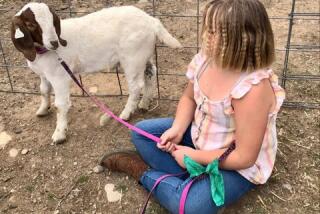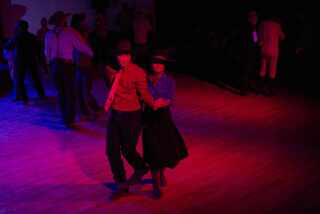It’s End of Chisholm Trail as Stockyards Go Out of the Auction Business : Cowtown: The final gavel comes down on the weekly cattle sales in Ft. Worth, marking the end of the city’s historic link to cattle drives of yesteryear.
- Share via
FT. WORTH, Tex. — Cowtown awakened one recent morning to learn it no longer was Cowtown.
Well, sort of.
“Going, going . . . gone,” announced a headline decorating the front page of the Ft. Worth Star-Telegram. Atop the story, the chilling news: “The 100-year era of cattle auctions at the Ft. Worth Stockyards comes to an end.”
No longer economically feasible, a spokesman explained.
Balderdash!
Strip the heart from San Francisco or the French Quarter from New Orleans. Siphon the beer out of Milwaukee or condemn the slot machines in Las Vegas. Black out the moon over Miami, if you must.
But don’t take the cows out of Cowtown.
It’s true. They’re gone. In fact, the final weekly cattle auction ended shortly before Christmas, with some 150 animals moving through the Stockyards complex.
“It’s sad,” said Sue McCafferty, president of the North Ft. Worth Historical Society.
“It’s terrible,” said Jerre Todd, a longtime activist in the Chisholm Trail Roundup, an annual celebration of the city’s historic link to the cattle drives of yesteryear.
“The Stockyards are just a dear part of Ft. Worth. And those cows were just as important as those sad-eyed country singers up the street at Filthy McNasty’s and Billy Bob’s.”
Billy Bob’s and McNasty’s are honky-tonks of some notoriety.
Despite the despair, live cattle sales of recent vintage were little more than token affairs anyway--romantic and nostalgic but rarely moneymakers.
Smaller, convenient auctions remain the bread and butter of the small producers who sell their animals in surrounding places, such as Gainesville, Weatherford, Mineral Wells and Cleburne.
On a new level, however, this town’s reputation as a cattle marketing center is secure. Unusual and different, but secure.
Still, half a century ago, more than a million cattle were marketed annually at the North Side facility. So were millions of sheep and any number of horses, hogs and mules.
In 1944, the peak year, 5,277,496 head of livestock passed through the Ft. Worth Stockyards.
The oldest working stockyards in America, the area along Exchange Avenue was known in its Champagne days as the “Wall Street of the West.”
More than a century ago, cattlemen gave the town its first economic security. In the 1860s and 1870s, they drove their herds up the Chisholm Trail, through Ft. Worth, to railheads in Kansas and Missouri.
“Ft. Worth was the last chance for drovers to buy flour, bacon, beans, dried fruit, coffee and other necessities for the long drives across the Indian Nations,” author-historian Leonard Sanders says in “How Ft. Worth Became the Texasmost City.”
Trail drivers returning from Kansas often reloaded in Ft. Worth for the final leg of the homeward trip.
A forerunner of the Ft. Worth Stockyards, Union Stockyards, sprang up in 1883. It included a livestock exchange building, hotel and saloon.
McCafferty of the historical society says nearly a quarter-million cows were auctioned there in 1896, and Ft. Worth “almost became the hog capital of the world.”
In the early 1900s, Swift and Armour, the nation’s leading meat companies, located plants in Ft. Worth, and by 1909 were processing 1.2 million cattle annually.
The town’s population nearly tripled to 73,312 between 1900 and 1910.
The meatpacking houses, like the cows, are gone now, but the Stockyards complex remains a national historic district, one of the largest in the United States.
And it is anything but dead, some argue.
“The cattle business is not gone, gone, gone from the Stockyards,” said Holt Hickman, a key player in the area’s tourist, entertainment and business developments. “It’s still a cattle center, it’s just done differently.
“Buying and selling cattle has changed, like going from an adding machine to a computer, or from radio to television.”
True.
Superior Livestock Auctions Inc., with offices in the Exchange Building, sold 860,000 head of cattle last year and projects 1993 sales of 920,000.
What’s different is that not one of those cows is in Ft. Worth.
Superior representatives film the cattle, or offerings, at the ranches, then mail catalogues to 5,000 registered buyers around the country. Via satellite, the company holds auctions twice monthly.
“I really think we’ll hit the million mark in 1994,” said Paul Branch, Superior’s branch manager.
So Cowtown’s not dead. It’s just gone uptown.
More to Read
Sign up for The Wild
We’ll help you find the best places to hike, bike and run, as well as the perfect silent spots for meditation and yoga.
You may occasionally receive promotional content from the Los Angeles Times.






